The Colors of the Circus Mosaic from Barcino (Roman Barcelona): Characterization, Provenance, and Technology Issues
Abstract
1. Introduction
2. Materials and Methods
2.1. The Circus Mosaic from Barcelona
2.2. Sampling and Methods
2.2.1. Colorimetry
2.2.2. Thin-Section Petrography (POM, CL)
2.2.3. SEM-EDS
2.2.4. tts-μXRD
2.2.5. XRF
2.2.6. Stable Isotopes Analyses
3. Results
3.1. Colorimetry
3.2. Stone Tesserae
3.2.1. Petrographic Characterization
Limestones (Tesserae #1, #2, #3, #4, #5, #9, and #11)
Sandstones (Tesserae #6 and #10)
Marble (Tessera #13)
3.2.2. Cathodoluminescence of Selected Samples
3.2.3. Isotopic Analysis of Tessera #13
3.3. Glass Tesserae
3.3.1. Petrographic Characterization
3.3.2. SEM-EDX Measurements
3.3.3. SR tts-μXRD Measurements
3.3.4. EDXRF Measurements
4. Archaeological Discussion
4.1. Provenance
4.2. Production Technology
4.2.1. Base Glass
4.2.2. Opacifiers
4.2.3. Colorants
5. Conclusions
- Ten samples were stone tesserae: seven limestones, two sandstones, and one marble. The provenance of four of the tesserae could be established: (i) a tessera made of Alveolina limestone (#9) of the early Eocene age from the southern Pyrenees; (ii) two tesserae made of siliciclastic sandstone (#6 and #10) of the Miocene age from Barcelona’s Montjuïc hill; and (iii) a tessera made of Carrara white marble (#13) from the Apuan Alps (Tuscany, Italy).
- Three samples were glass tesserae: two bluish tesserae (#7 and #8) containing antimony-based opacifiers and a green tessera (#12) containing tin-based opacifiers and a base glass with hints of being recycled.
Author Contributions
Funding
Data Availability Statement
Acknowledgments
Conflicts of Interest
References
- Dunbabin, K.M.D. Mosaics of the Greek and Roman World; Cambridge University Press: New York, NY, USA, 2001. [Google Scholar]
- Blázquez, J.M. La cultura romana en Hispania: Mosaicos, arquitectura, pintura. In Historia de España Antigua, vol.II; Cátedra: Madrid, Spain, 1978. [Google Scholar]
- Blázquez, J.M. Mosaicos Romanos de España; Cátedra: Madrid, Spain, 2009. [Google Scholar]
- Guardia, M. Los Mosaicos de la Antiguedad Tardía en Hispania: Estudios de Iconografía; PPU: Barcelona, Spain, 1992. [Google Scholar]
- Blázquez, J.M. Villas hispano-romanas del Bajo Imperio decoradas con mosaicos mitológicos. In Mitología e Historia en los Mosaicos Romanos; Neira, L., Ed.; Ediciones JC: Madrid, Spain, 2010; pp. 89–110. [Google Scholar]
- Kiilerich, B. The State of Early Christian Iconography in the Twenty-first Century. Stud. Iconogr. 2015, 36, 99–134. [Google Scholar]
- Guimier-Sorbets, A.-M.; Nenna, M.-D. L’emploi du verre, de la faïence et de la peinture dans les mosaïques de Délos. Bulletin de Correspondance Hellénique 1992. [Google Scholar] [CrossRef]
- Boschetti, C. Vitreous Materials in Early Mosaics in Italy: Faience, Egyptian Blue, and Glass. J. Glass Stud. 2011, 53, 59–91. [Google Scholar]
- Del Hoyo Calleja, J. El mosaico del mitreo de Mérida. In Obras de Grecia y Roma; Montero Montero, M., Arcaz Pozo, J., Eds.; Sociedad Española de Estudios Clásicos: Alcalá de Henares, Spain, 2001; pp. 135–157. [Google Scholar]
- Licenziati, F.; Calligaro, T. Study of mosaic glass tesserae from Delos, Greece using a combination of portable μ-Raman and X-ray fluorescence spectrometry. J. Archaeol. Sci. Rep. 2016, 7, 640–648. [Google Scholar] [CrossRef]
- Fiorentino, S.; Chinni, T.; Vandini, M. Ravenna, its mosaics and the contribution of archaeometry. A systematic reassessment on literature data related to glass tesserae and new considerations. J. Cult. Herit. 2020, 46, 335–349. [Google Scholar] [CrossRef]
- Bonnerot, O.; Ceglia, A.; Michaelides, D. Technology and materials of Early Christian Cypriot wall mosaics. J. Archaeol. Sci. Rep. 2016, 7, 649–661. [Google Scholar] [CrossRef]
- Zoleo, A.; Brustolon, M.; Barbon, A.; Silvestri, A.; Molin, G.; Tonietto, S. Fe(III) and Mn(II) EPR quantitation in glass fragments from the palaeo-Christian mosaic of St. Prosdocimus (Padova, NE Italy): Archaeometric and colour correlations. J. Cult. Herit. 2015, 16, 322–328. [Google Scholar] [CrossRef]
- Drünert, F.; Palamara, E.; Zacharias, N.; Wondraczek, L.; Möncke, D. Ancient Roman nano-technology: Insight into the manufacture of mosaic tesserae opacified by calcium antimonate. J. Eur. Ceram. Soc. 2018, 38, 4799–4805. [Google Scholar] [CrossRef]
- Ricca, M.; Belfiore, C.M.; Ruffolo, S.A.; Barca, D.; De Buergo, M.A.; Crisci, G.M.; La Russa, M.F. Multi-analytical approach applied to the provenance study of marbles used as covering slabs in the archaeological submerged site of Baia (Naples, Italy): The case of the “Villa con ingresso a protiro”. Appl. Surf. Sci. 2015, 357, 1369–1379. [Google Scholar] [CrossRef]
- Šmuc, A.; Dolenec, M.; Lesar-Kikelj, M.; Lux, J.; Pflaum, M.; Šeme, B.; Županek, B.; Gale, L.; Kramar, S. Variety of Black and White Limestone Tesserae Used in Ancient Mosaics in Slovenia. Archaeometry 2017, 59, 205–221. [Google Scholar] [CrossRef]
- Tasker, A.; Wilkinson, I.P.; Fulford, M.G.; Williams, M. Provenance of chalk tesserae from Brading Roman Villa, Isle of Wight, UK. Proc. Geol. Assoc. 2011, 122, 933–937. [Google Scholar] [CrossRef][Green Version]
- Barca, D.; Fiorenza, E.; D’Andrea, M.; Le Pera, E.; Musella, M.; Sudano, F.; Taliano Grasso, A. Chemical and Petrographic Characterization of Stone and Glass Tesserae in the Nereid and Geometric Mosaics from the S. Aloe Quarter in Vibo Valentia–Calabria, Italy. Minerals 2019, 9, 729. [Google Scholar] [CrossRef]
- Barral i Altet, X. Les Mosaïques Romaines et Medievales de la Regio Laietana; Publicaciones Eventuales: Barcelona, Spain, 1978. [Google Scholar]
- Darder Lissón, M. El mosaic circenc de Barcino. Implicacions iconogràfiques a partir de les aportacions semàntiques. Butlleí la R. Acadèmia Catalana Belles Arts St. Jordi 1994, VII–VIII, 251–281. [Google Scholar]
- Hübner, E. Musaico di Barcellona raffigurante giuochi circensi. Annali dell’Instituto di Corrispondenza Archeologica 1863, 35, 135–172. [Google Scholar]
- Balil, A. Mosaicos circenses de Barcelona y Gerona. Boletín de la Real Academia de la Historia 1962, 151, 257–399. [Google Scholar]
- Barral i Altet, X. Unes pintures murals romanes inèdites i el mosaic amb curses de circ de Barcelona. Cuadernos de Arqueología e Historia de la Ciudad 1973, 15, 31–68. [Google Scholar]
- Balil Illana, A. Sobre la cronología del mosaico circense de Barcelona. Archivo Español de Arqueología 1965, 38, 125. [Google Scholar]
- Fauth, F.; Peral, I.; Popescu, C.; Knapp, M. The new Material Science Powder Diffraction beamline at ALBA Synchrotron. Powder Diffr. 2013, 28, 360–370. [Google Scholar] [CrossRef]
- Vallcorba, O.; Rius, J. d2Dplot: 2D X-ray diffraction data processing and analysis for through-the-substrate microdiffraction. J. Appl. Cryst. 2019, 52, 478–484. [Google Scholar] [CrossRef]
- García-Florentino, C.; Maguregui, M.; Romera-Fernández, M.; Queralt, I.; Margui, E.; Madariaga, J.M. Usefulness of a Dual Macro- and Micro-Energy-Dispersive X-Ray Fluorescence Spectrometer to Develop Quantitative Methodologies for Historic Mortar and Related Materials Characterization. Anal. Chem. 2018, 90, 5795–5802. [Google Scholar] [CrossRef]
- Hård, A.; Sivik, L.; Tonnquist, G. NCS, natural color system—From concept to research and applications. Part II. Color. Res. Appl. 1996, 21, 206–220. [Google Scholar] [CrossRef]
- Hård, A.; Sivik, L.; Tonnquist, G. NCS, natural color system—From concept to research and applications. Part I. Color. Res. Appl. 1996, 21, 180–205. [Google Scholar] [CrossRef]
- Ma, W.; Walton, M.; Cossairt, O.; Bearman, G.; Doehne, E. Crowd-sourced mobile phone images for heritage conservation monitoring. In Proceedings of the Digital Heritage 2015 International Congress, Granada, Spain, 28 September–2 October 2015; IEEE: Piscataway, NJ, USA, 2015; Volume 1, pp. 111–114. [Google Scholar] [CrossRef]
- Wess, T. Smartphone citizen science: Can a conservation hypothesis be tested using non specialist technology? Herit. Sci. 2017, 5, 35. [Google Scholar] [CrossRef]
- Connolly, C.; Fleiss, T. A study of efficiency and accuracy in the transformation from RGB to CIELAB color space. IEEE Trans. Image Process. 1997, 6, 1046–1048. [Google Scholar] [CrossRef] [PubMed]
- Munsell, A.H. Atlas of the Munsell Color System; Howland & Company Inc.: Wadsworth, OH, USA, 1915. [Google Scholar]
- Gerharz, R.R.; Lantermann, R.; Spennemann, D.R. Munsell Color Charts: A Necessity for Archaeologists? Aust. J. Hist. Archaeol. 1988, 6, 88–95. [Google Scholar]
- Pegalajar, M.C.; Ruiz, L.G.B.; Sánchez-Marañón, M.; Mansilla, L. A Munsell colour-based approach for soil classification using Fuzzy Logic and Artificial Neural Networks. Fuzzy Sets Syst. 2020, 401, 38–54. [Google Scholar] [CrossRef]
- Dunham, R.J. Classification of Carbonate Rocks According to Depositional Texture1. In Classification of Carbonate Rocks—A Symposium; American Association of Petroleum Geologists: Tulsa, OK, USA, 1962; ISBN 9781629812366. [Google Scholar] [CrossRef]
- Hiatt, E.E.; Pufahl, P.K. Cathodoluminescence petrography of carbonate rocks: Application tounderstanding diagenesis, reservoir quality, and pore system evolution. In Cathodoluminescence and Its Application to Geoscience; Coulson, I., Ed.; Mineralogical Association of Canada: Québec, QC, Canada, 2014; pp. 75–96. [Google Scholar]
- Mason, R.A. Effects of heating and prolonged electron bombardment on cathodoluminescence emission from synthetic calcite. Chem. Geol. 1994, 111, 245–260. [Google Scholar] [CrossRef]
- Machel, H.G. Application of Cathodoluminescence to Carbonate Diagenesis. In Cathodoluminescence in Geosciences; Pagel, M., Barbin, V., Blanc, P., Ohnenstetter, D., Eds.; Springer: Berlin/Heidelberg, Germany, 2000; pp. 271–301. ISBN 978-3-662-04086-7. [Google Scholar] [CrossRef]
- England, J.; Cusack, M.; Paterson, N.W.; Edwards, P.; Lee, M.R.; Martin, R. Hyperspectral cathodoluminescence imaging of modern and fossil carbonate shells. J. Geophys. Res. Biogeosci. 2006, 111. [Google Scholar] [CrossRef]
- Parcerisa, D.; Gámez, D.; Gómez-Gras, D.; Usera, J.; Simó, A.; Carrera, J.A. Estratigrafía y petrología del subsuelo precuaternario del sector SW de la depresión de Barcelona (Cadenas Costeras Catalanas, NE de Iberia). Revista de la Sociedad Geológica de España 2008, 21, 93–109. [Google Scholar]
- Casas, L.; Di Febo, R.; Parcerisa, D. Petrographic Markers for Archaeometric Identification of Montjuïc Sandstone, the Flagship Stone of Barcelona (NE Spain). Minerals 2020, 10, 154. [Google Scholar] [CrossRef]
- Barbin, V.; Ramseyer, K.; Decrouez, D.; Burns, S.; Chamay, J.; Maier, J. Cathodoluminescence of white marbles: An overview. Archaeometry 2007, 34, 175–183. [Google Scholar] [CrossRef]
- Blanc, P.; Lapuente Mercadal, M.P.; Gutiérrez Garcia-Moreno, A. A New Database of the Quantitative Cathodoluminescence of the Main Quarry Marbles Used in Antiquity. Minerals 2020, 10, 381. [Google Scholar] [CrossRef]
- Lapuente, M.P.; Royo, H. Cathodoluminescence for the Characterization of ancient Marble: Problems and research perspective. In Ancient Quarries and Building Sites in Asia Minor, Research on Hierapolis in Phrygia and Other Cities in South-Western Anatolia: Archaeology, Archaeometry, Conservation; Ismaelli, T., Scardozzi, G., Eds.; Edipuglia: Bari, Italy, 2016; pp. 541–548. ISBN 978-88-7228-819-1. [Google Scholar] [CrossRef]
- Herz, N. Provenance determination of Neolithic to Classical Mediterranean marbles isotopes. Archaeometry 1992, 34, 185–194. [Google Scholar] [CrossRef]
- Brilli, M.; Savin, M.-C. Provenance study of the white marbles of the “Baths of Elagabalus” at the Palatine Hill in Rome. Archaeol. Anthropol. Sci. 2019, 11. [Google Scholar] [CrossRef]
- Gorgoni, C.; Lazzarini, L.; Pallante, P.; Turi, B. An Updated and Detailed Mineropetrographic and C-O Stable Isotopic Reference Database for the Main Mediterranean Marbles Used in Antiquity. In ASMOSIA 5—Interdisciplinary Studies on Ancient Stone, Proceedings of the Fifth International Conference of the Association for the Study of Marble and Other Stones in Antiquity, Museum of Fine Arts, Boston, MA, USA, 11 to 15 June 1998; Hermann, J.J., Herz, N., Newton, R., Eds.; Archetype: London, UK, 2002; pp. 115–131. [Google Scholar]
- Attanasio, D.; Bruno, M.; Prochaska, W.; Yavuz, A.B. A Multi-Method Database of the Black and White Marbles of Göktepe (Aphrodisias), Including Isotopic, EPR, Trace and Petrographic Data. Archaeometry 2015, 57, 217–245. [Google Scholar] [CrossRef]
- Antonelli, F.; Lazzarini, L. An updated petrographic and isotopic reference database for white marbles used in antiquity. Rend. Lincei 2015, 26, 399–413. [Google Scholar] [CrossRef]
- Vataj, E.; Hobdari, E.; Röhrs, S.; Vandenabele, P.; Civici, N. Analytical characterization of glass tesserae from mosaics of early Christian basilicas in Albania. Appl. Phys. A 2016, 123, 76. [Google Scholar] [CrossRef]
- Schibille, N.; Boschetti, C.; Valero Tévar, M.Á.; Veron, E.; de Juan Ares, J. The Color Palette of the Mosaics in the Roman Villa of Noheda (Spain). Minerals 2020, 10, 272. [Google Scholar] [CrossRef]
- Flügel, E.; Flügel, C. Applied microfacies analysis: Provenance studies of Roman mosaic stones. Facies 1997, 37, 1–48. [Google Scholar] [CrossRef]
- Hamon, Y.; Deschamps, R.; Joseph, P.; Doligez, B.; Schmitz, J.; Lerat, O. Integrated workflow for characterizing and modeling a mixed sedimentary system: The Ilerdian Alveolina Limestone Formation (Graus–Tremp Basin, Spain). Comptes Rendus Geosci. 2016, 348, 520–530. [Google Scholar] [CrossRef]
- Mey, P.H.; Nagtegaal, P.J.; Roberti, K.J.; Hartevelt, J.J.A. Lithostratigraphic subdivision of Post-Hercynian deposits in the South-Central Pyrenees, Spain. Leidse Geologische Mededelingen 1968, 41, 221–228. [Google Scholar]
- Garrido, E.A. Arquitectura y Urbanismo de Barcino en Época alto Imperial: La Decoración Arquitectónica de Edificios Públicos y Privados. 2011. Available online: https://www.tdx.cat/handle/10803/48641#page=1 (accessed on 1 June 2021).
- Ravotto, A. La Muralla de Barcino 2017. Available online: https://www.tdx.cat/handle/10803/402256#page=1 (accessed on 1 June 2021).
- Ruiz Rodríguez, J.C. La importación de Marmor Lunense en la Hispania Romana: El Paradigma de Tàrraco. Butlletí Arqueològic. 2012, 34–35, 87–114. [Google Scholar]
- Fabre, G.; Mayer, M.; Rodà, I. Inscriptions Romaines de Catalogne, IV: Barcino; Universitat de Barcelona: Barcelona, Spain, 1997; ISBN 9788447516568. [Google Scholar]
- Garrido, A.; Álvarez, A.; Domènech, A.; Gutierrez Garcia-M, A.; Llanza, I.; Royo, H. Marmora and other stones in the architectural decoration of early imperial Barcino (Barcelona, Spain). In Proceedings of the X International Conference of Association for the Study of Marble & Other Stones in Antiquity (ASMOSIA X), Rome, Italy, 21–26 May 2012; L’Erma di Bretschneider: Rome, Italy, 2012; pp. 135–142. [Google Scholar] [CrossRef]
- Foster, H.E.; Jackson, C.M. The composition of “naturally coloured” late Roman vessel glass from Britain and the implications for models of glass production and supply. J. Archaeol. Sci. 2009, 36, 189–204. [Google Scholar] [CrossRef]
- Silvestri, A.; Tonietto, S.; Molin, G.; Guerriero, P. The palaeo-Christian glass mosaic of St. Prosdocimus (Padova, Italy): Archaeometric characterisation of tesserae with copper- or tin-based opacifiers. J. Archaeol. Sci. 2014, 42, 51–67. [Google Scholar] [CrossRef]
- Boschetti, C.; Henderson, J.; Evans, J.; Leonelli, C. Mosaic tesserae from Italy and the production of Mediterranean coloured glass (4rd century BCE-4th century CE). Part I: Chemical composition and technology. J. Archaeol. Sci. Rep. 2016, 7, 303–311. [Google Scholar] [CrossRef]
- Ganio, M.; Boyen, S.; Fenn, T.; Scott, R.; Vanhoutte, S.; Gimeno, D.; Degryse, P. Roman glass across the Empire: An elemental and isotopic characterization. J. Anal. At. Spectrom. 2012, 27, 743–753. [Google Scholar] [CrossRef]
- Silvestri, A.; Molin, G.; Salviulo, G. The colourless glass of Iulia Felix. J. Archaeol. Sci. 2008, 35, 331–341. [Google Scholar] [CrossRef]
- Freestone, I.C. The Recycling and Reuse of Roman Glass: Analytical Approaches. J. Glass Stud. 2015, 57, 29–40. [Google Scholar]
- Maltoni, S.; Silvestri, A. Innovation and tradition in the fourth century mosaic of the Casa delle Bestie Ferite in Aquileia, Italy: Archaeometric characterisation of the glass tesserae. Archaeol. Anthropol. Sci. 2018, 10, 415–429. [Google Scholar] [CrossRef]
- Abd-Allah, R. Devitrification behavior of corroded glass: Four case studies. Mediterr. Archaeol. Archaeom. 2007, 7, 39–49. [Google Scholar]
- Paynter, S.; Jackson, C.M. Re-used Roman rubbish: A thousand years of recycling glass. Post-Class. Archaeol. 2016, 6, 31–52. [Google Scholar]
- Silvestri, A.; Marcante, A. The glass of Nogara (Verona): A “window” on production technology of mid-Medieval times in Northern Italy. J. Archaeol. Sci. 2011, 38, 2509–2522. [Google Scholar] [CrossRef]
- Schibille, N.; Freestone, I.C. Composition, Production and Procurement of Glass at San Vincenzo al Volturno: An Early Medieval Monastic Complex in Southern Italy. PLoS ONE 2013, 8, 1–13. [Google Scholar] [CrossRef] [PubMed]
- Boschetti, C.; Leonelli, C. Glass Coloring and Recycling in Late Antiquity: A New Case Study from Aquileia (Italy). J. Glass Stud. 2016, 58, 69–86. [Google Scholar]
- Foy, D. Les Revêtements muraux en verre à la fin de l’Antiquité: Quelques témoignages en Gaule méridionale. J. Glass Stud. 2008, 50, 51–65. [Google Scholar]
- Lahlil, S.; Biron, I.; Galoisy, L.; Morin, G. Rediscovering ancient glass technologies through the examination of opacifier crystals. Appl. Phys. A 2008, 92, 109–116. [Google Scholar] [CrossRef]
- Piña, C.; Arriola, H.; Nava, N. Study of Malayaite and Malayaite Cobalt Pigment. Hyperfine Interact. 2005, 161, 93–97. [Google Scholar] [CrossRef]
- Takenouchi, S. Hydrothermal synthesis and consideration of the genesis of malayaite. Mineralium Deposita 1971, 6, 335–347. [Google Scholar] [CrossRef]
- Maltoni, S.; Silvestri, A. A Mosaic of Colors: Investigating Production Technologies of Roman Glass Tesserae from Northeastern Italy. Minerals 2018, 8, 255. [Google Scholar] [CrossRef]
- Tite, M.; Pradell, T.; Shortland, A. Discovery, production and use of tin-based opacifiers in glasses, enamels and glazes from the late Iron age onwards: A reassessment *. Archaeometry 2008, 50, 67–84. [Google Scholar] [CrossRef]
- Turner, W.; Rooksby, H. Further historical studies based on X-ray diffraction methods of the reagents employed in making opal and opaque glasses. Jahrbuch des Römisch-Germanischen Zentralmuseums Mainz 1961, 8, 1–6. [Google Scholar] [CrossRef]
- Verità, M.; Maggetti, M.; Sagui, L.; Santopadre, P. Colors of Roman Glass: An Investigation of the Yellow Sectilia in the Gorga Collection. J. Glass Stud. 2013, 55, 39–52. [Google Scholar]
- Klysubun, W.; Hauzenberger, C.A.; Ravel, B.; Klysubun, P.; Huang, Y.; Wongtepa, W.; Sombunchoo, P. Understanding the blue color in antique mosaic mirrored glass from the Temple of the Emerald Buddha, Thailand. X-Ray Spectrom. 2015, 44, 116–123. [Google Scholar] [CrossRef]
- Arletti, R.; Quartieri, S.; Vezzalini, G. Glass mosaic tesserae from Pompeii: An archeometrical investigation. Periodico di Mineralogia 2006, 76, 25–38. [Google Scholar]
- Moretti, C.; Hreglich, S. Opacification and colouring of glass by the use of “anime”. Glas. Technol. 1984, 25, 277–282. [Google Scholar]
- Matin, M. Tin-based opacifiers in archaeological glass and ceramic glazes: A review and new perspectives. Archaeol. Anthropol. Sci. 2019, 11, 1155–1167. [Google Scholar] [CrossRef]
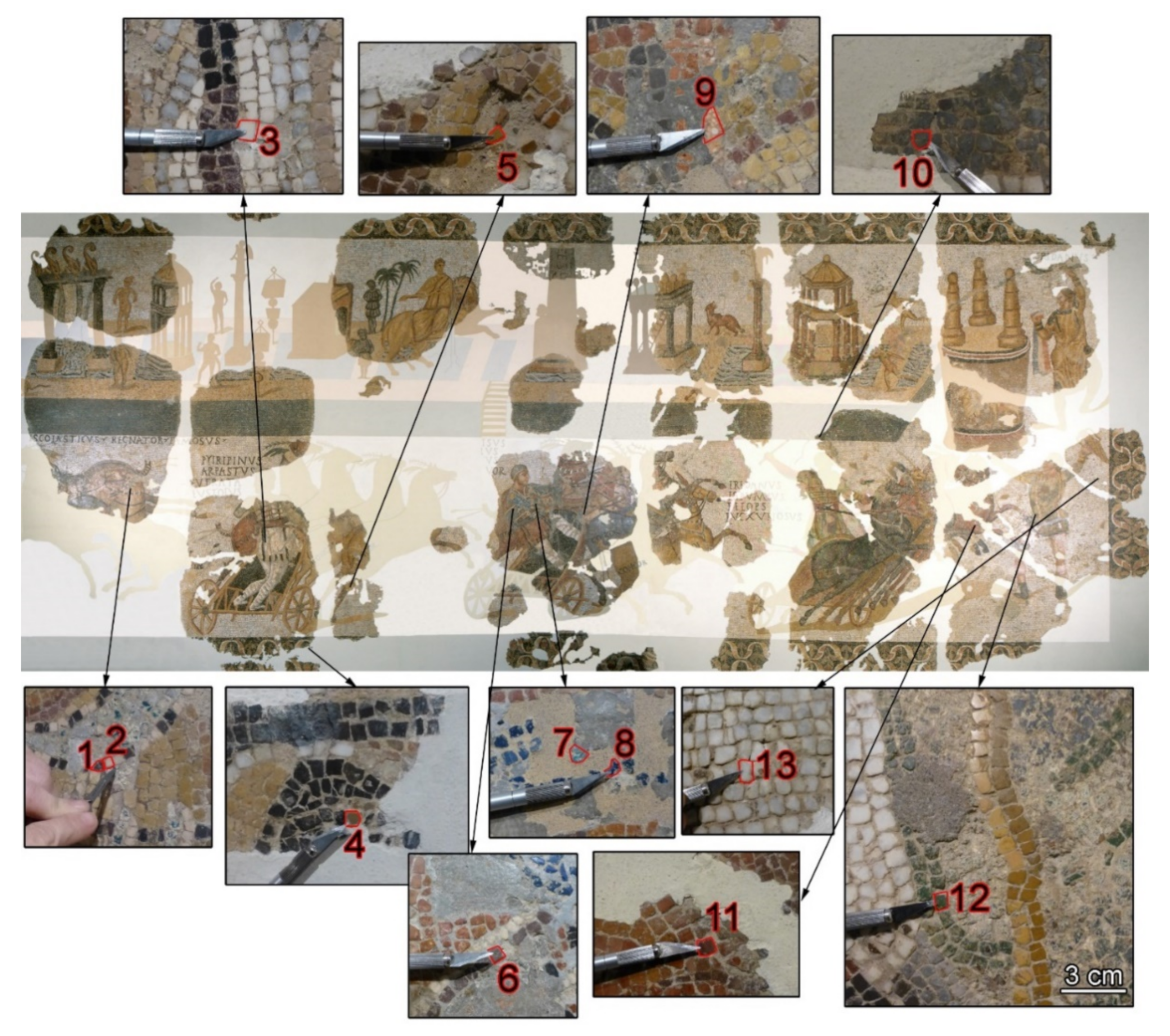
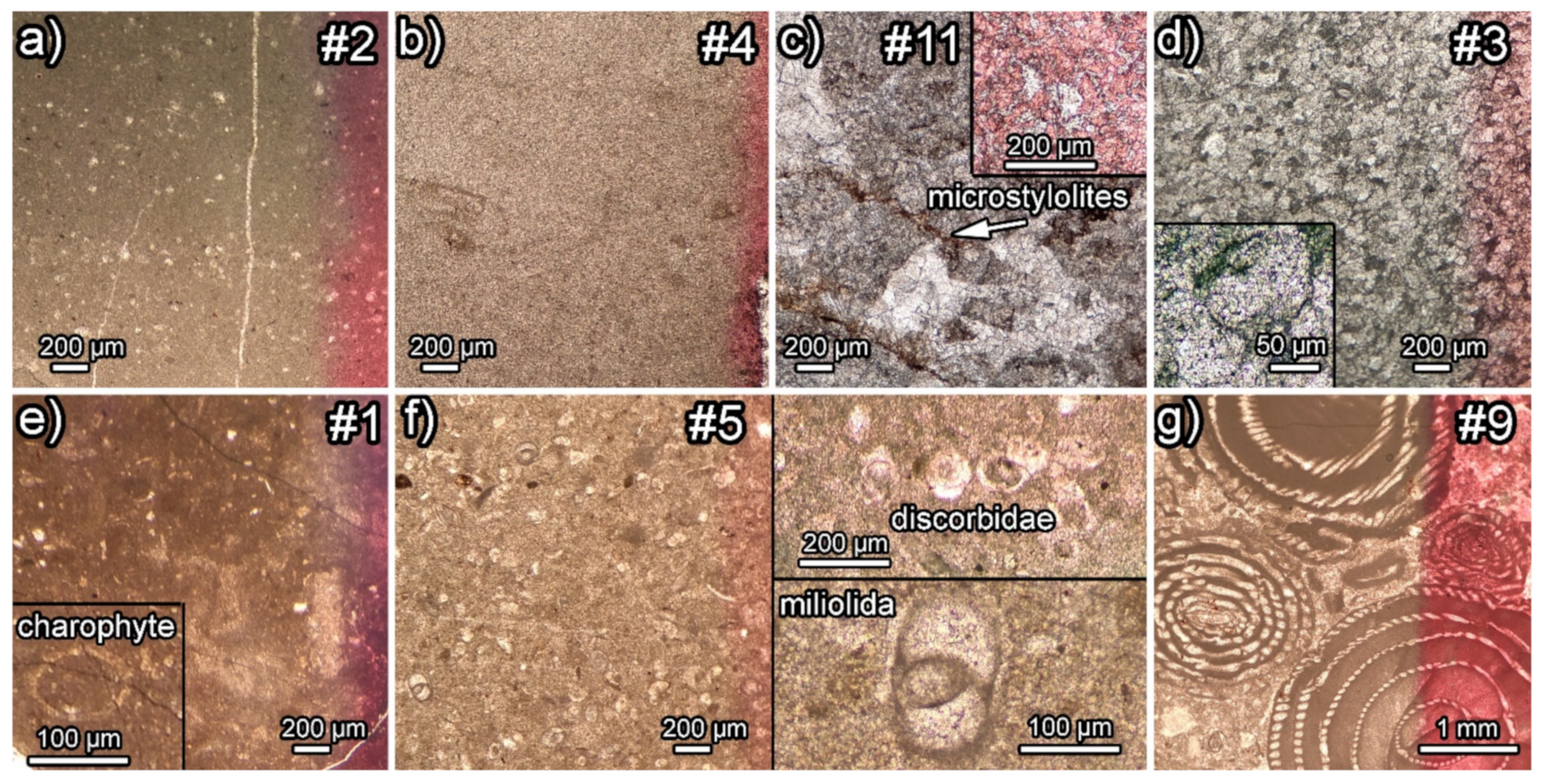
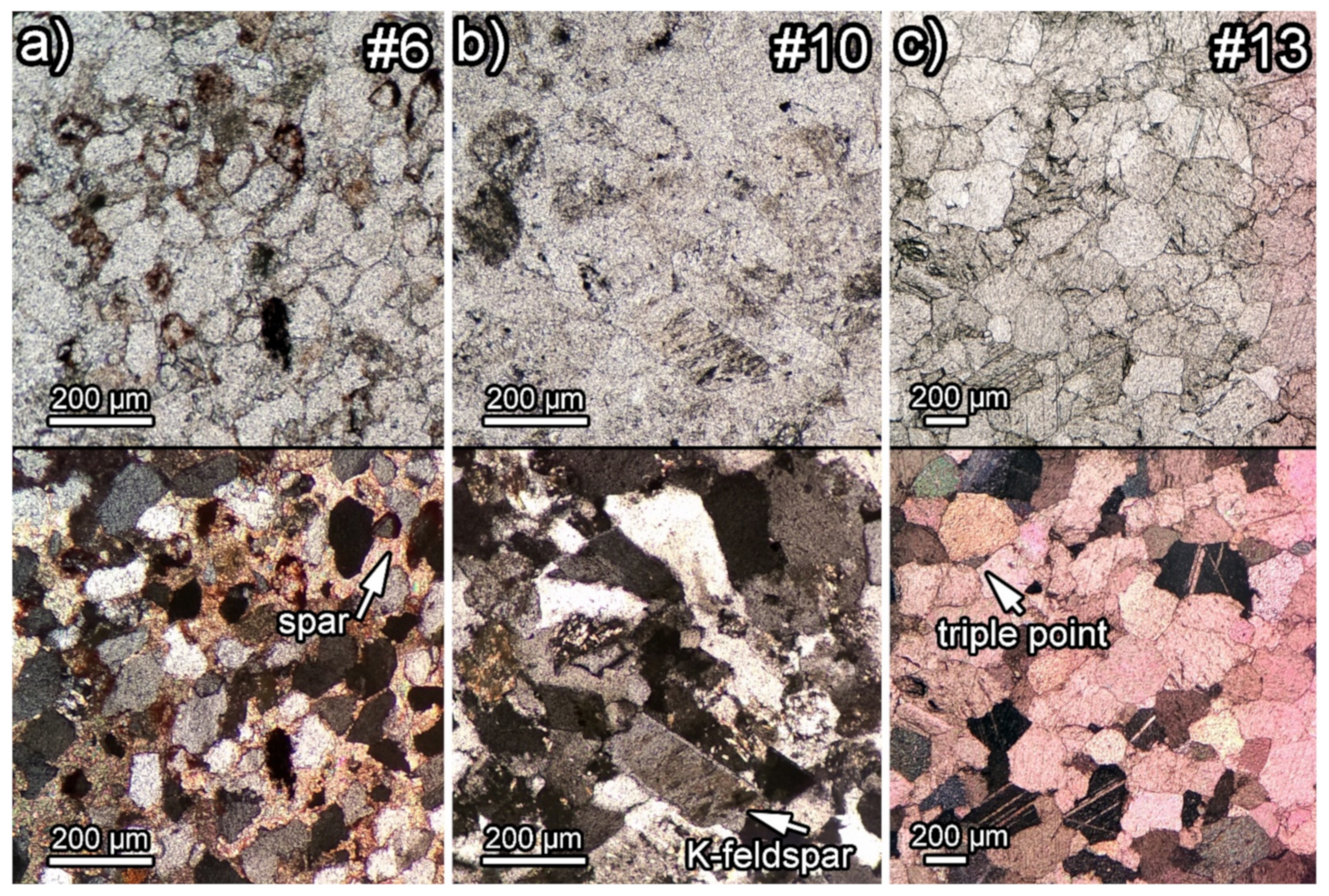
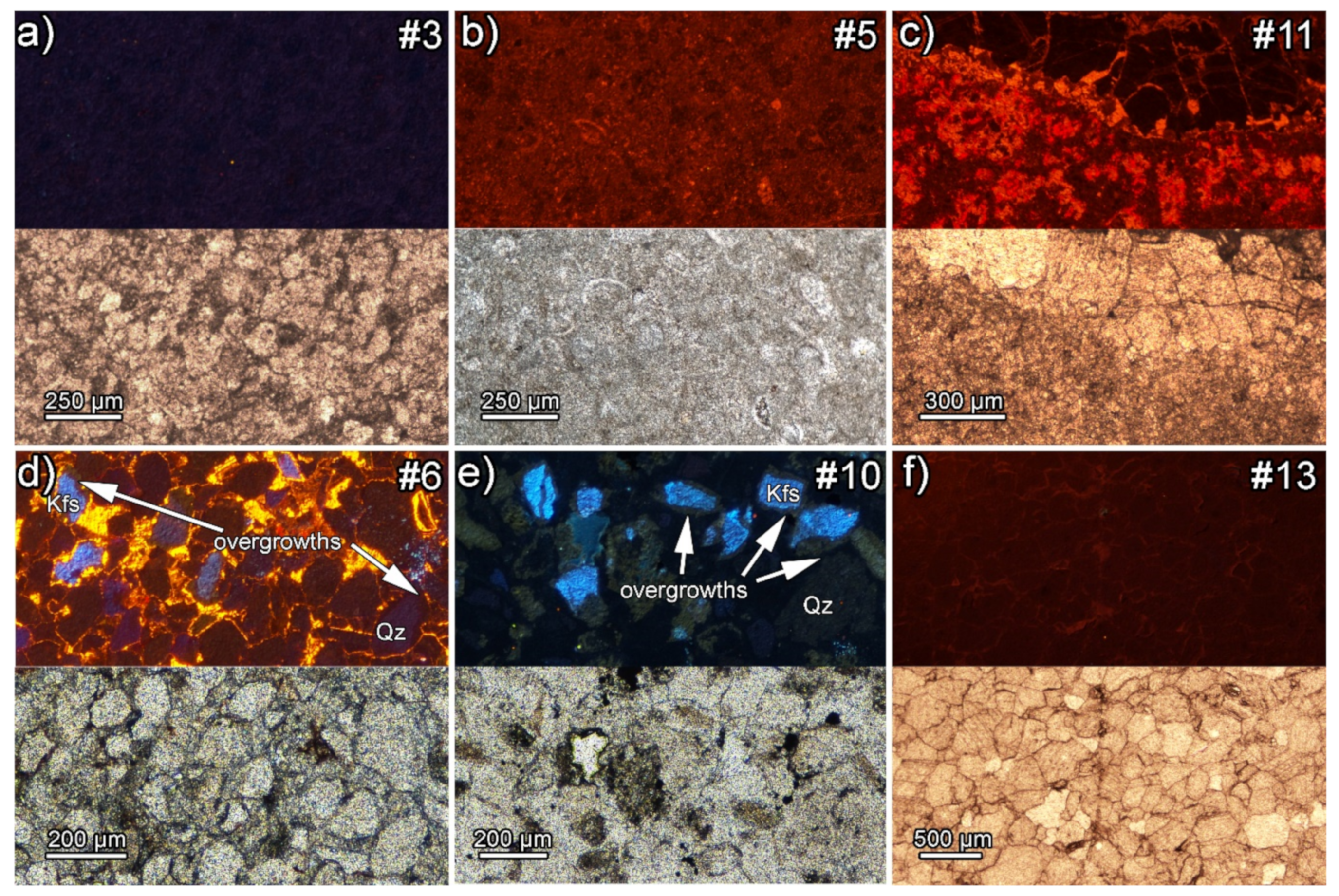
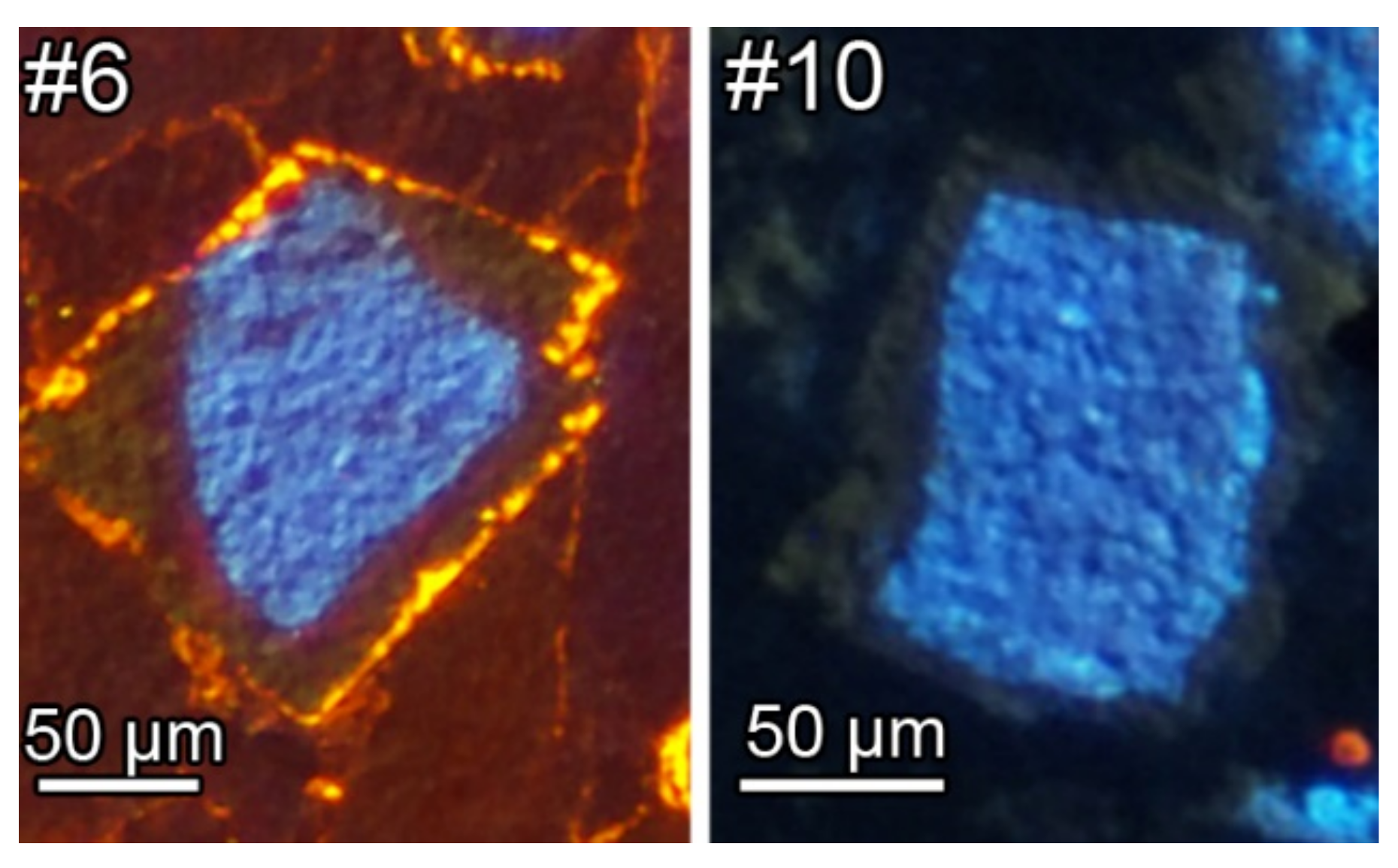
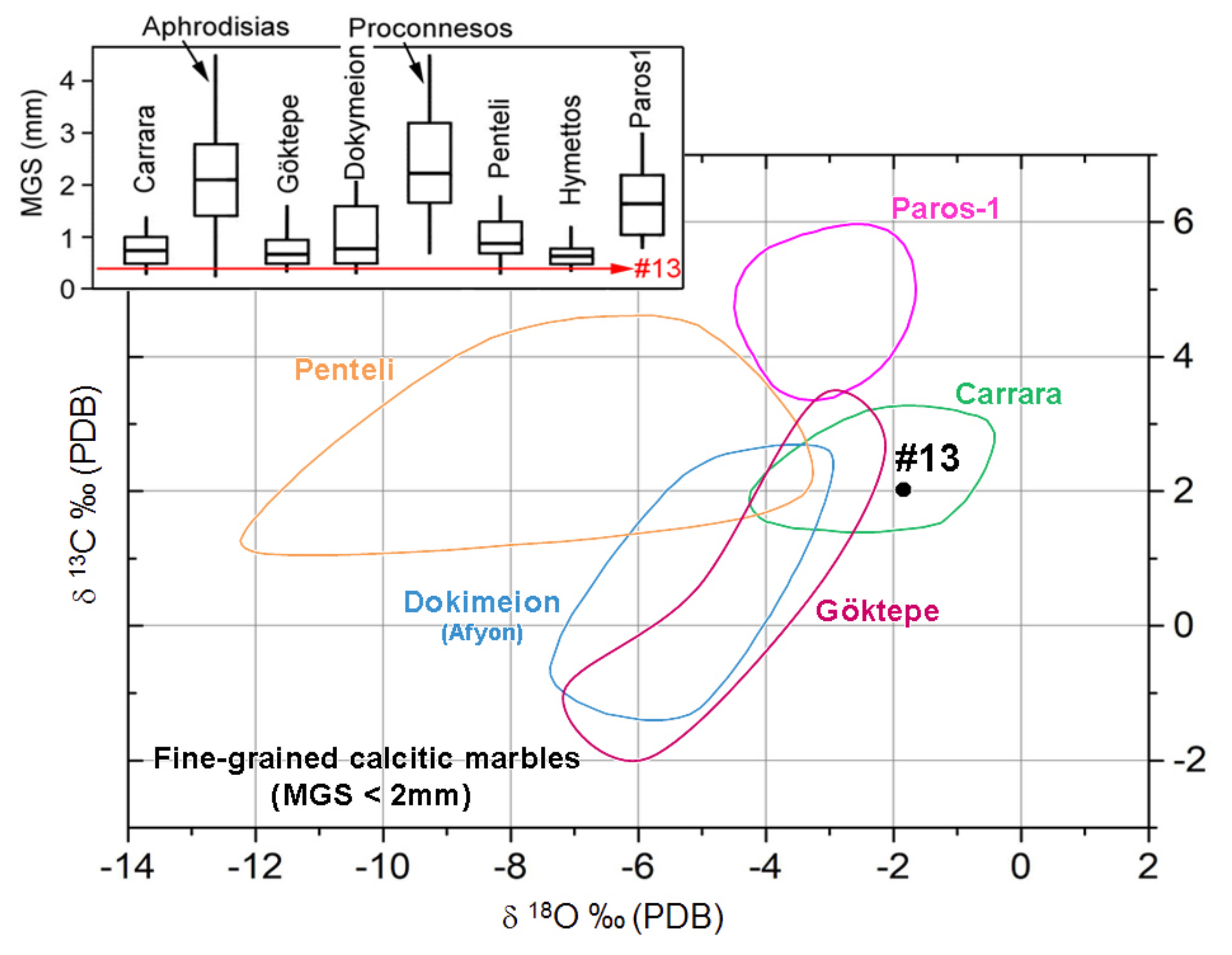
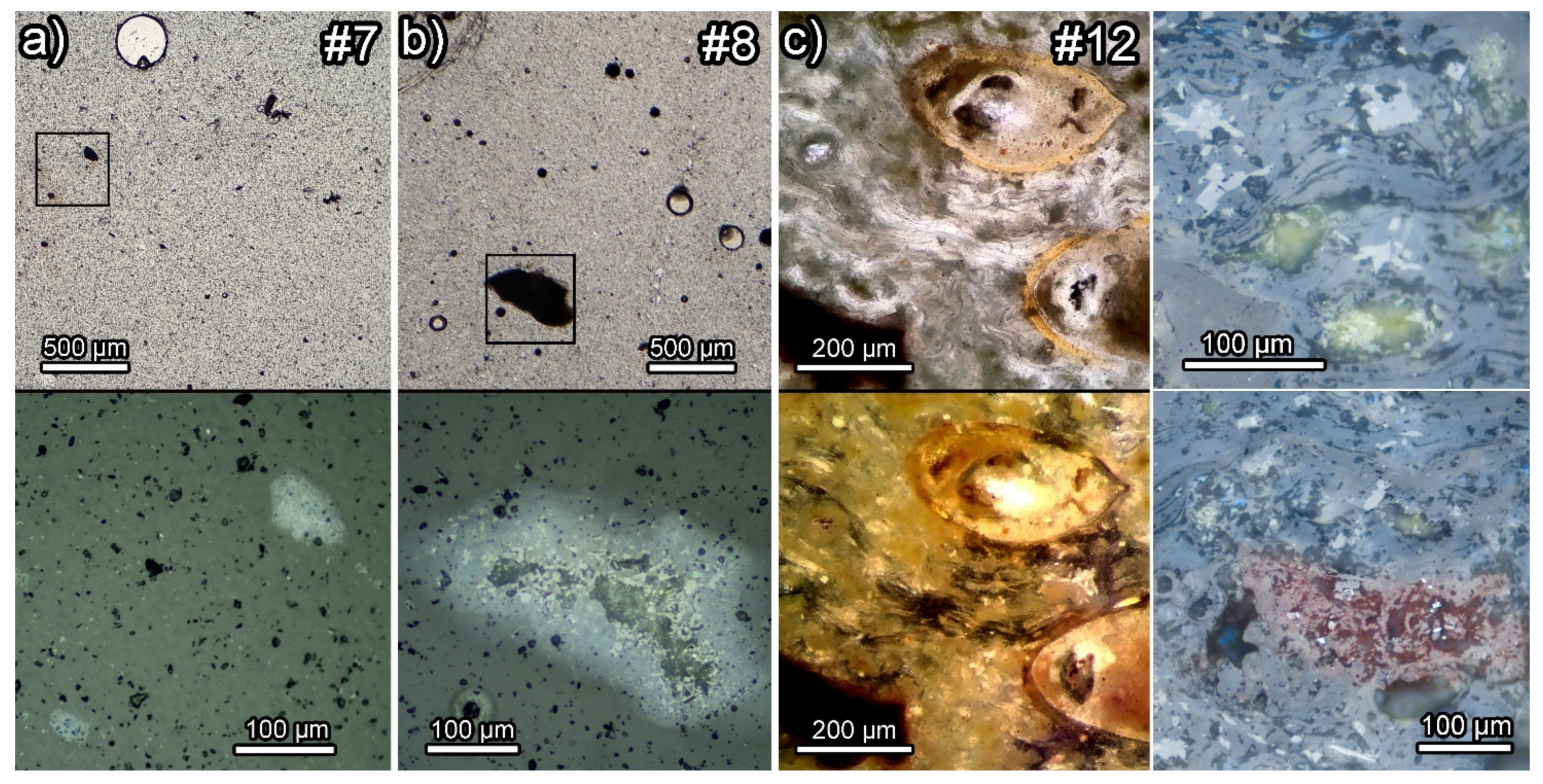
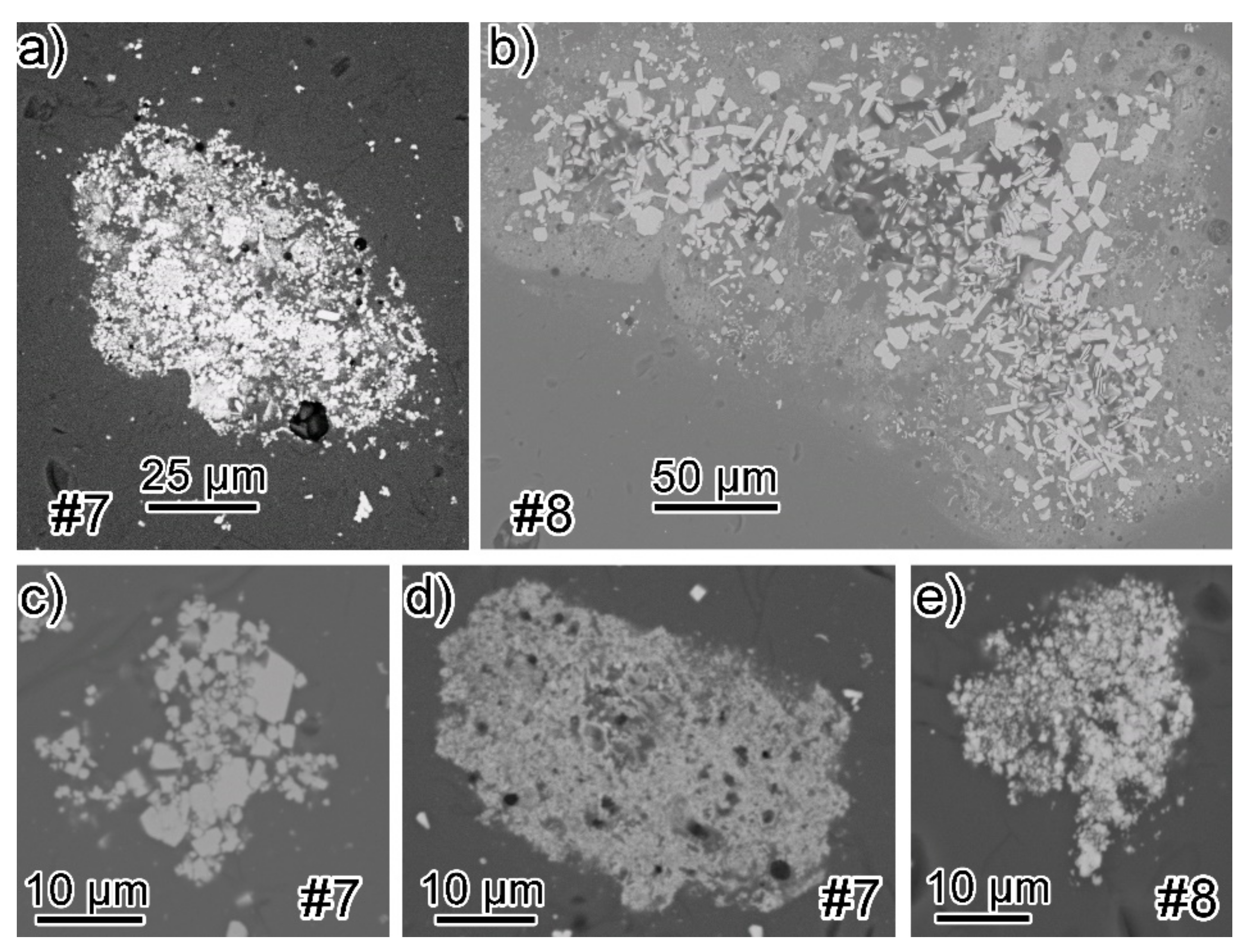
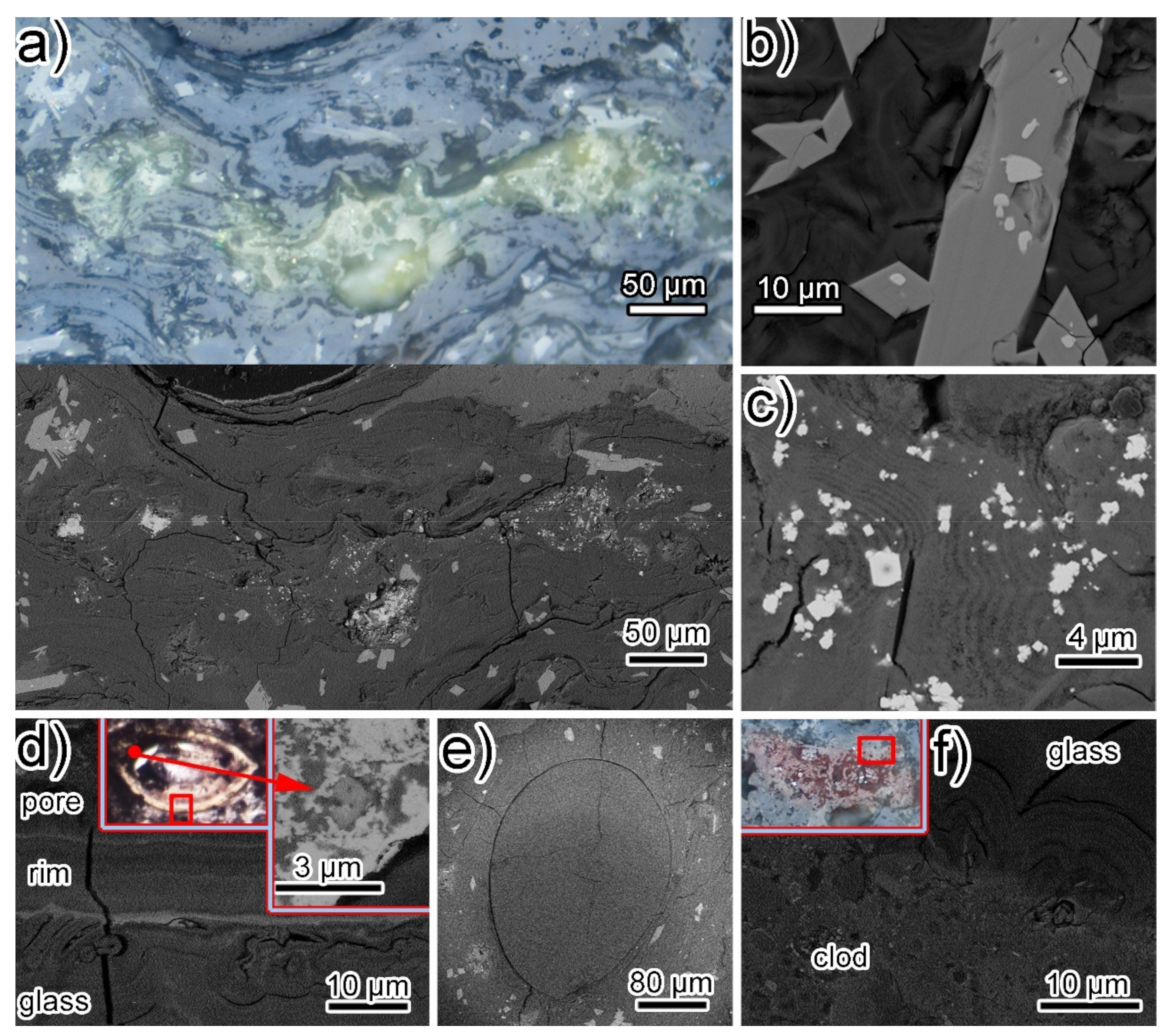
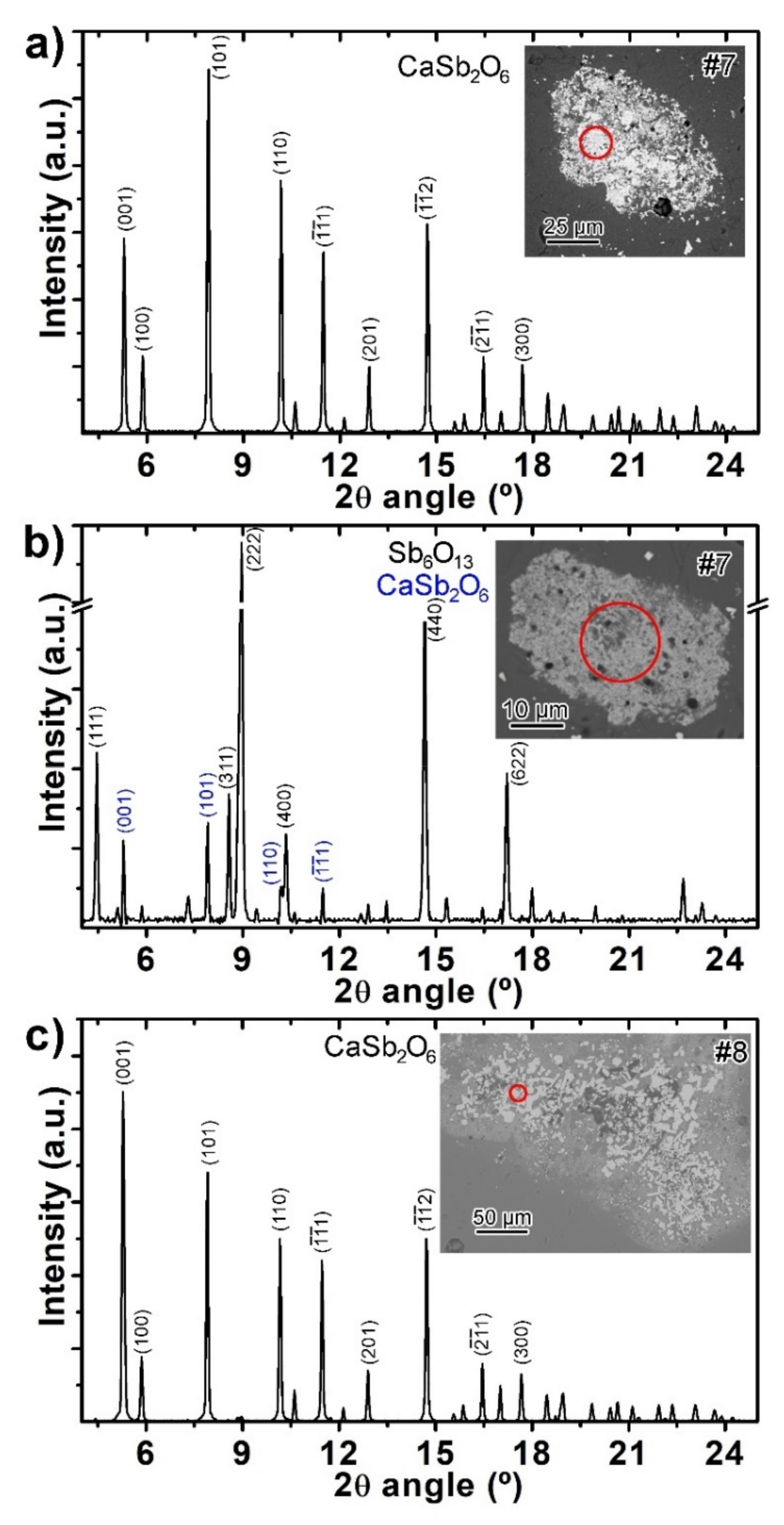

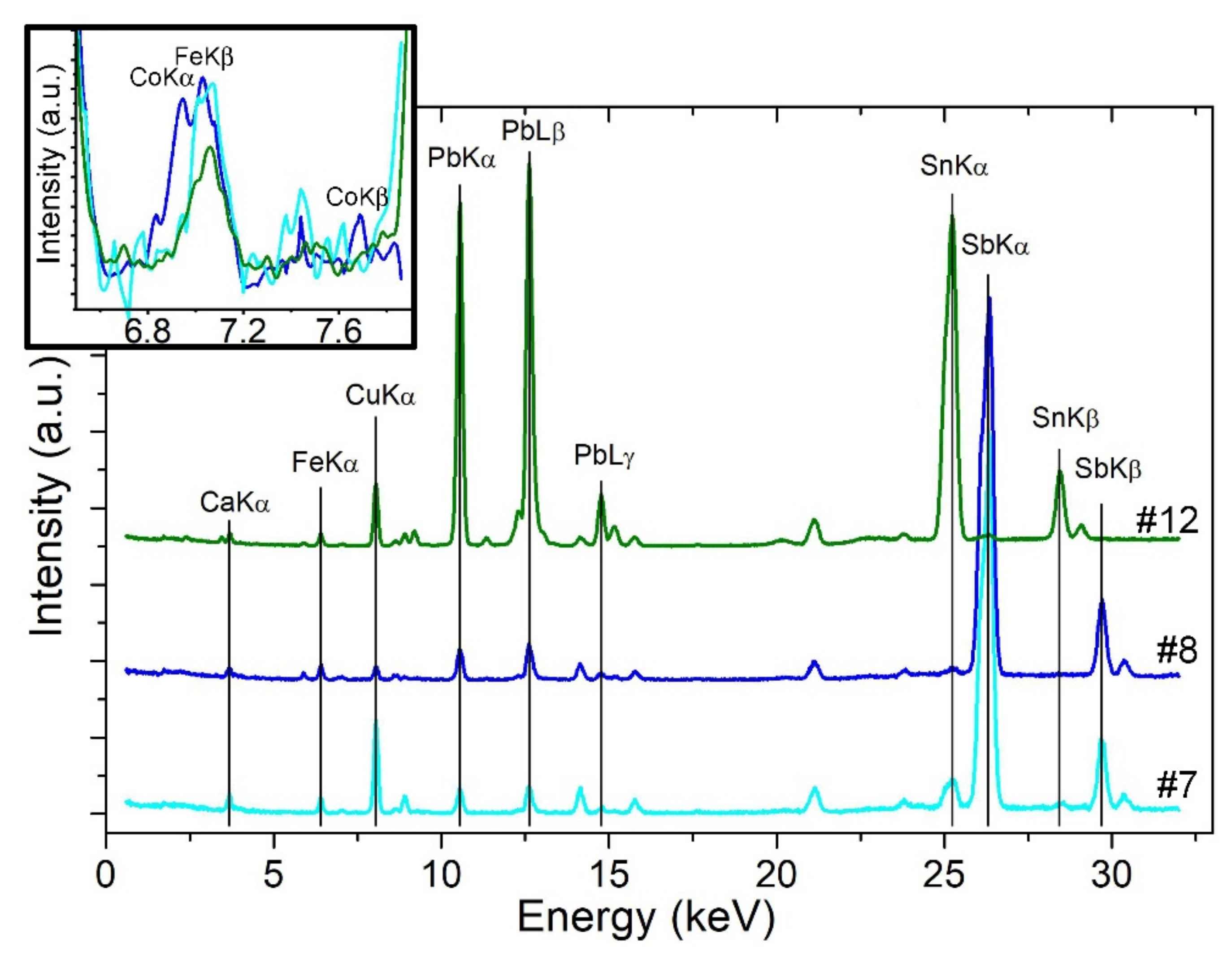
| Sample | #1 | #2 | #3 | #4 | #5 | #6 | #7 |
| Picture | 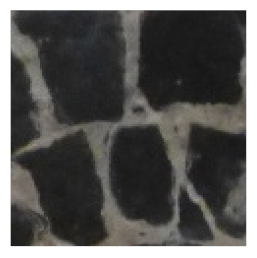 |  | 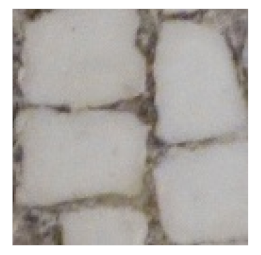 | 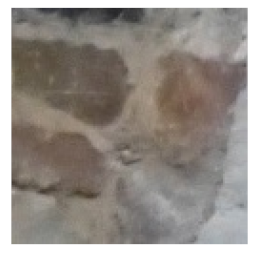 | 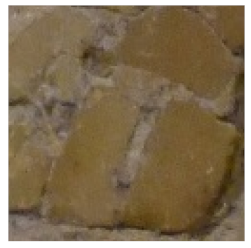 |  | 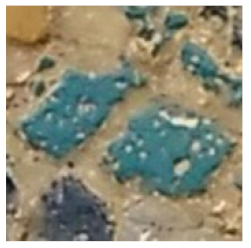 |
| NCS | S 7005 Y20R | S 2010 Y50R | S 1005 Y30R | S 5010 Y10R | S 4020 Y30R | S 7010 Y90R | S 5020 B50G |
| L* | 35.64 | 75.83 | 86.65 | 53.97 | 58.2 | 32.49 | 47.97 |
| a* | 1.91 | 6.92 | 1.25 | 3.11 | 9.93 | 9.45 | −14.19 |
| b* | 6.21 | 13.27 | 10.05 | 13.74 | 21.76 | 5.67 | −3.43 |
| Color name | dark gray | pinkish gray | white | grayish brown | light yellowish brown | dusky red | grayish arctic blue |
| Sample | #8 | #9 | #10 | #11 | #12 | #13 | |
| Picture | 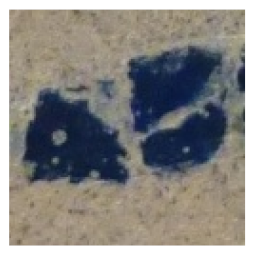 | 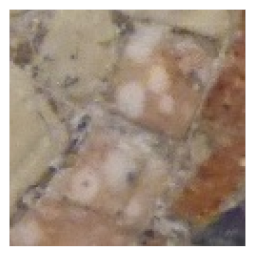 | 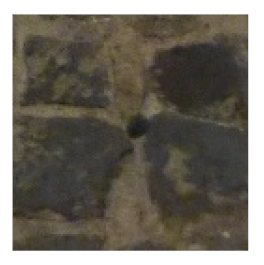 | 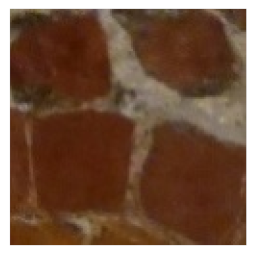 |  |  | |
| NCS | S 7010 B10G | S 2010 Y70R | S 6005 G50Y | S 5020 Y90R | S 6020 G30Y | S 3005 Y20R | |
| L* | 33.19 | 75.76 | 47.56 | 44.61 | 38.76 | 69.27 | |
| a* | −5.51 | 7.54 | −2.91 | 15.4 | −9.89 | 1.38 | |
| b* | −5.98 | 9.54 | 5.14 | 8.48 | 13.96 | 10.02 | |
| Color name | dark grayish azure | pinkish white | greenish gray | weak red | sage green | light gray |
| Compound | #7 (Arctic Blue) | #8 (Dark Azure) | #12 (Sage Green) | |||
|---|---|---|---|---|---|---|
| m | σ | m | σ | m | σ | |
| Na2O (%) | 13.3 | 0.3 | 14.9 | 1 | 1.2 | 0.2 |
| MgO (%) | nd | nd | 0.5 | 0.1 | ||
| Al2O3 (%) | 2.6 | 0.2 | 1.7 | 1.5 | 7.7 | 0.8 |
| SiO2 (%) | 70.5 | 1.8 | 71.9 | 2.7 | 74.9 | 5.5 |
| Cl (%) | 1.1 | 0.1 | 2.2 | 1 | od | |
| K2O (%) | 0.9 | 0.1 | od | 3.2 | 1.3 | |
| CaO (%) | 6.4 | 0.2 | 7.8 | 0.4 | 3.2 | 0.8 |
| MnO (%) | 0.7 | 0.1 | nd | nd | ||
| FeO (%) | 0.9 | 0.2 | od | 1.6 | 1.3 | |
| CuO (%) | nd | od | 0.9 | 0.8 | ||
| SnO2 (%) | nd | nd | 2.2 | 1.7 | ||
| Sb2O5 (%) | 3.4 | 2.1 | nd | nd | ||
| PbO (%) | od | nd | 4.7 | 3.0 | ||
| Compound | #7 (Arctic Blue) | #8 (Dark Azure) | #12 (Green) |
|---|---|---|---|
| Na2O (%) | 4.4 | 4.5 | 2.2 |
| Al2O3 (%) | 4.6 | 5.6 | 0.8 |
| SiO2 (%) | 69.6 | 70.2 | 41.6 |
| K2O (%) | 0.9 | 1.4 | 1.6 |
| CaO (%) | 11.6 | 9.6 | 12.4 |
| Fe2O3 (%) | 1.5 | 1.8 | 4.0 |
| CuO (%) | 0.7 | 0.2 | 2.4 |
| SnO2 (%) | 0.4 | 0.1 | 13.8 |
| Sb2O5 (%) | 2.7 | 4.0 | 0.3 |
| PbO (%) | 0.4 | 0.8 | 20.1 |
| Mn (ppm) | 125 | 1540 | 2420 |
| Co (ppm) | nd | 305 | 115 |
| Zn (ppm) | 600 | nd | 2710 |
| Rb (ppm) | 30 | 50 | 65 |
| Sr (ppm) | 975 | 755 | 1090 |
| Zr (ppm) | 225 | 260 | 195 |
Publisher’s Note: MDPI stays neutral with regard to jurisdictional claims in published maps and institutional affiliations. |
© 2021 by the authors. Licensee MDPI, Basel, Switzerland. This article is an open access article distributed under the terms and conditions of the Creative Commons Attribution (CC BY) license (https://creativecommons.org/licenses/by/4.0/).
Share and Cite
Casas, L.; Di Febo, R.; Boix, C.; Egea, A.; Vallcorba, O.; Queralt, I.; Anglisano, A.; Moreno, I.; Andino, L. The Colors of the Circus Mosaic from Barcino (Roman Barcelona): Characterization, Provenance, and Technology Issues. Minerals 2021, 11, 746. https://doi.org/10.3390/min11070746
Casas L, Di Febo R, Boix C, Egea A, Vallcorba O, Queralt I, Anglisano A, Moreno I, Andino L. The Colors of the Circus Mosaic from Barcino (Roman Barcelona): Characterization, Provenance, and Technology Issues. Minerals. 2021; 11(7):746. https://doi.org/10.3390/min11070746
Chicago/Turabian StyleCasas, Lluís, Roberta Di Febo, Carme Boix, Albert Egea, Oriol Vallcorba, Ignasi Queralt, Anna Anglisano, Isabel Moreno, and Lorena Andino. 2021. "The Colors of the Circus Mosaic from Barcino (Roman Barcelona): Characterization, Provenance, and Technology Issues" Minerals 11, no. 7: 746. https://doi.org/10.3390/min11070746
APA StyleCasas, L., Di Febo, R., Boix, C., Egea, A., Vallcorba, O., Queralt, I., Anglisano, A., Moreno, I., & Andino, L. (2021). The Colors of the Circus Mosaic from Barcino (Roman Barcelona): Characterization, Provenance, and Technology Issues. Minerals, 11(7), 746. https://doi.org/10.3390/min11070746












